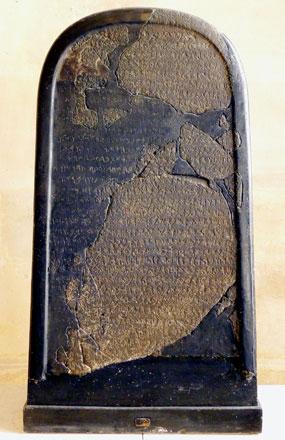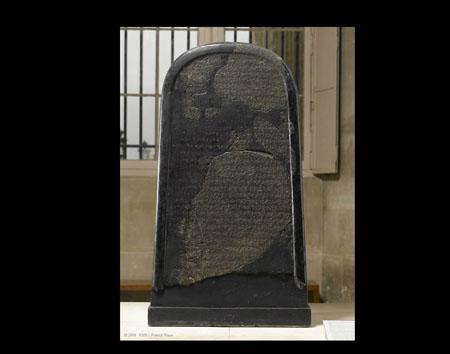You are here
Centre planning protest to demand return of Mesha Stele from Louvre
By Muath Freij - Apr 12,2016 - Last updated at Apr 12,2016

The Mesha Stele, which is currently on display at the Louvre Museum (Photo courtesy of Wikimedia Commons)
AMMAN — The Mesha Centre for Studies and Human Rights will submit a request this week to the governor of Amman asking for permission to picket the French embassy in Amman to demand the return of the Mesha Stele from France, the centre’s president, Daifallah Hdeithat, said Tuesday.
Hdeithat said in previous remarks to The Jordan Times that the stele was taken from Theeban, the historical capital of the kingdom of Moab, in 1868 when Jordan was under Ottoman rule and moved to Jaffa by an Austrian.
Afterwards, the Mesha Stele was moved to the Louvre Museum, and it has been there for 150 years.
“We will provide the governor with an official request so that our move would be legal, and we want to be protected during the event as well,” Hdeithat told The Jordan Times over the phone.
In October 2014, the French embassy in Amman informed the centre it sent the Louvre Museum the request to retrieve the Mesha Stele artefact.
Since then, no updates have emerged on the request, according to Hdeithat.
In July 2015, the French ambassador to Jordan at the time said Jordan and France are two sovereign countries that are bound by international agreements, and this issue cannot be resolved except within the framework of these agreements.
“The Mesha Stele is a symbol of power, and the greatness of the country and its people, and this belongs to Jordan,” Hdeithat added.
The inscription on the stele of King Mesha “constitutes one of the most important direct accounts of the history of the world that is related in the Bible”, according to the Louvre.
“The inscription pays tribute to the sovereign, celebrating his great construction work and victories over the kingdom of Israel during the reign of Ahab, son of Omri,” the museum says on its website.
It also includes the mention of “Israel” in its earliest known written occurrence.
The arched shape of the stele and the basalt used are “characteristic of the votive steles erected in the Levant since the Bronze Age, from Ugarit on the Syrian coast to Hazor in Galilee”, according to the Louvre.
“The complete absence of figurative representation on this particular stele is exceptional, however, as is the predominant place given to the text,” the museum says.
The identification of present-day Theeban “as the biblical site of Dibon has been confirmed by the text of the stele and American excavations over the years that have shed new light on the capital of the kingdom of Moab”, according to the museum.
Related Articles
The French embassy in Amman has informed the Mesha Centre for Studies and Human Rights that it has sent the Louvre Museum the request to retrieve the Mesha Stele artefact, Mesha Centre President Daifallah Hdeithat said Tuesday.
The Mesha Centre for Studies and Human Rights on Sunday delivered an official request to the French embassy in Amman for the return of the Mesha Stele artefact from the Louvre Museum to Jordan.
AMMAN — French Ambassador to Jordan Caroline Dumas on Tuesday stressed the French government’s understanding of the historic importance of t

















